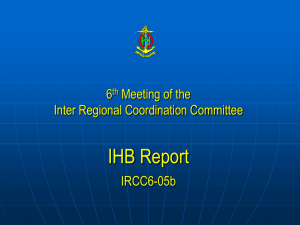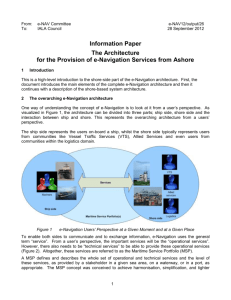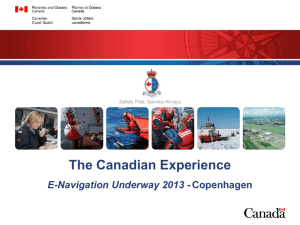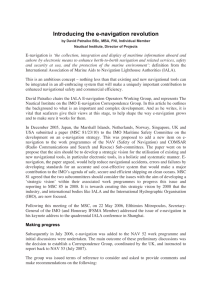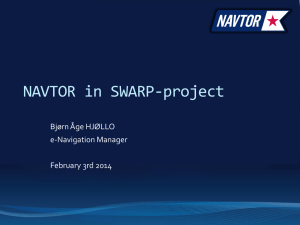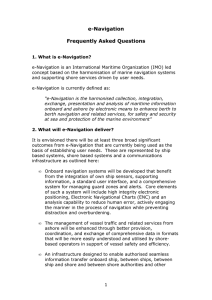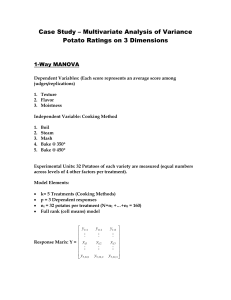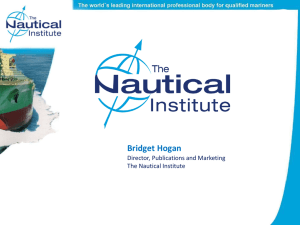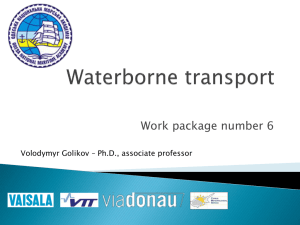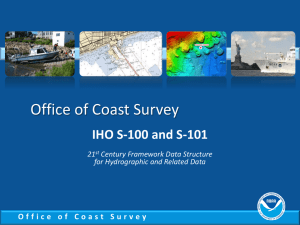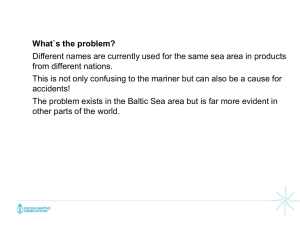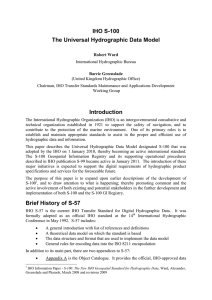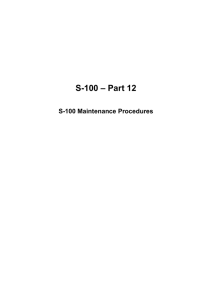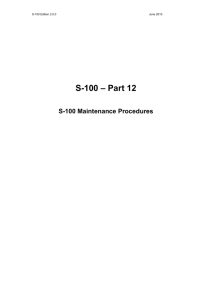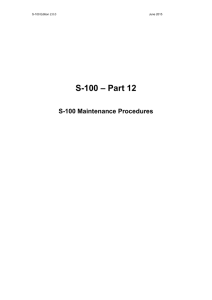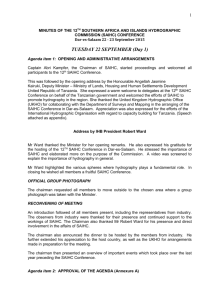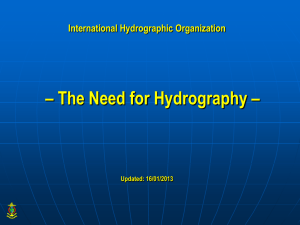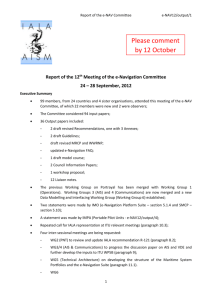navigation information
advertisement
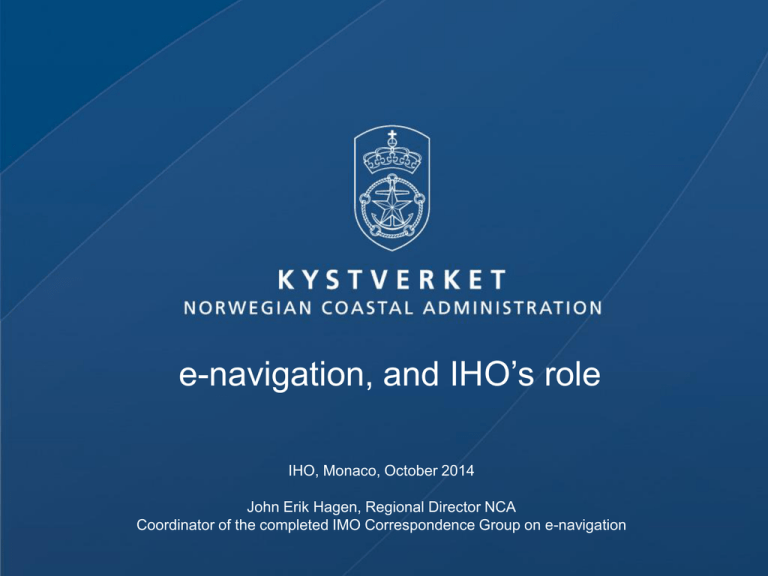
e-navigation, and IHO’s role IHO, Monaco, October 2014 John Erik Hagen, Regional Director NCA Coordinator of the completed IMO Correspondence Group on e-navigation Technology Development • The last decades have seen huge developments in technology within navigation and communication systems. • Although ships now carry Global Satellite Navigation Systems (GNSS) and will soon all have reliable Electronic Chart Display and Information Systems (ECDIS), their use on board is not fully integrated and harmonised with other existing systems and those of other ships and ashore. Human Element • The human element, including training, competency, language skills, workload and motivation are essential in today’s world. • Administrative burden, information overload and ergonomics are prominent concerns. • A clear need has been identified for the application of good ergonomic principles in a well-structured human machine interface as part of the e-navigation strategy. The purpose of e-navigation • Improve electronic information exchange to: – Enhance berth-to-berth navigation; – Provide simplification to improve safety, security and environment and; – Facilitate and increase efficiency of maritime trade and transport. e-navigation aims to… • Minimize navigational errors, incidents and accidents through the transmission and display of positional and navigational information in electronic formats. e-navigation aims to… • Use up-to-date electronic charts to facilitate route, position and other related information making full use of electronic charts and position fixing systems. IMO’s vision of e-navigation • Navigation systems on board – Integration – Standard user interface – Preventing distraction and overburdening • Management of vessel traffic information ashore – Coordination – Exchange of comprehensive harmonized data • Communications infrastructure – Seamless harmonized information transfer The vision of e-navigation was defined in MSC 85/26 annex 20 paragraph 4 Key Components of e-Navigation Five agreed solutions 1. Improved, harmonized and user-friendly bridge design; 2. Means for standardized and automated reporting; 3. Improved reliability, resilience and integrity of bridge equipment and navigation information; 4. Integration and presentation of available information in graphical displays received via communication equipment; and 5. Improved Communication of VTS Service Portfolio. Relevant items for future involvement by IHO The solutions and the e-navigation strategy • The five agreed solutions provide a holistic approach to the e-navigation strategy, connecting the ship with the shore and vice-versa • The solutions focus on improved, and more user friendly bridge systems and equipment and efficient information exchange ship-shore and vice versa • Important to this is improved and harmonized Communications which is the backbone of e-navigation using a common data structure IHO S-100 data structure IMO MSC 90 approved: • The use of the IHO's S-100 standard as the baseline for creating a framework for data access and services under the scope of SOLAS. • A way forward for developing a Common Maritime Data Structure (CMDS); and consequently • The overarching e-navigation architecture; IHO S-100 data structure MSC 90 also authorised, in consultation with other organizations, • the establishment of an IMO/IHO Harmonization Group on Data Modeling to consider matters related to the framework for data access and information services under the scope of SOLAS and, in particular, with a view to: – harmonize and standardize formats for the collection, exchange and distribution of data, processes and procedures for the collection of data; and – the development of open standard interfaces. Test bed on IHO S-100 • NCA, in co-operation with MPA, held a workshop in Singapore to demonstrate the use of the S-100 framework data standard and to consider potential synergies between e-navigation and the Marine Electronic Highway (MEH) project in the Straits of Malacca and Singapore. • The results showed the suitability of the IHO S-100 data structure for e-navigation information The role of IHO • Provide adequate up to date chart information in IHO S100 format (S3) • Support the industry in adopting IHO S-100 based equipment (S4) • Support and coordinate the activities of other organizations adopting IHO S-100 for other data structures via the IMO/IHO harmonization group as an example (S4) • Encourage IHO member states to further develop relevant MSPs (S5) Maritime Service Portfolios • There are many different types of shore based services in most given situations or locations such as ports, coastal and high seas. • There is a need to identify these shore based functions and services in a globally standardised way. • Harmonising and standardising these services results in the Maritime Service Portfolios (MSPs). Maritime Service Portfolios MSP1 VTS Information Service (IS) MSP9 Telemedical Maritime Assistance Service MSP2 Navigational Assistance Service (NAS) MSP10 Maritime Assistance Service (MAS) MSP3 Traffic Organization Service (TOS) MSP11 Nautical Chart Service MSP4 Local Port Service (LPS) MSP12 Nautical Publications Service MSP5 Maritime Safety Information (MSI) Service MSP13 Ice Navigation Service MSP14 Meteorological Information Service MSP15 Real-Time Hydrographic and Environmental Information Services MSP16 Search and Rescue (SAR) Service MSP6 Pilotage Service MSP7 Tugs Service MSP8 Vessel Shore Reporting Relevant items for future involvement by IHO Key enablers for Global Implementation Being developed: • The guidelines on HCD, SQA and Usability (S1) • Global standard for data exchange (IHO S-100) (S2) • Maritime service portfolios (S5) To be further developed: • Harmonised equipment standards on-board (S1) • Resilient navigation on board (PNT) (S3) • On-board interconnectivity and integration (S4) • VTS and Coastal state infrastructure (S5) Tasks for implementation • A number of tasks have been identified to complete the implementation of e-navigation by 2019 • IMO Member states are encouraged to lead this work • Involvement by industry and other organisations is also essential to complete the tasks • Contribution and co-operation with IHO, IEC, IALA, CIRM, ICS, BIMCO and others is important e-navigation is a Strategy developed by the IMO It could: 1. bring about increased safety and security of navigation; 2. bring increased transport efficiency and better protection of the environment; 3. promote better data exchange and communication between ships and the ship and shore; and 4. bring well-designed more user centred and integrated equipment on ships. What's next • IMO MSC 94 is invited: - To approve the draft e-navigation Strategy Implementation Plan (SIP) and; - that the tasks identified in the SIP to be accepted outputs in IMOs High-level Action Plan for 2016-2017 and 20182019. Thank you for your attention!
